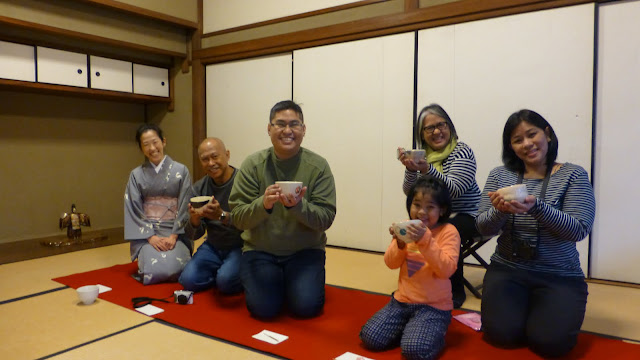After that excellent matsusakagyu lunch at Yakiniku M, my betsubara (Japanese term for "second stomach") was direly in need of dessert. I needed my sugar fix and make that with a heavy dose of caffeine please!
To end our day on a "sweet" note, Minako san of All Star Osaka Walk shepherded us back on the subway bound for Matsuyamachi, just two stops away. With all the wagyu we had just eaten, perhaps we should have walked to burn off the (saturated) fat and calories.
Matsuyamachi Station serves a quiet residential neighbourhood with alleys and back streets that have houses dating back from almost a century ago. Our destination was this renovated old house with a courtyard. Minako san said this had once been a samurai's house, dismantled and brought here all the way from Nagoya.
There are different small shops on the ground floor -- an optical shop with stylish and unique eyeglasses, a leather shop specialising in handmade bags and purses and even an artisanal chocolate maker.
A small boutique has traditional Japanese cloth bags and small crafts. Everything is so kawaii!
However we were here not to shop (well, at least not yet) but to experience the time honoured Japanese chado or tea ceremony. We walked up an old, creaky and steep wooden staircase and into this tatami room where the tea ceremony would be held.
This is Salon de Alice, a place where Japanese traditions like the tea ceremony and the art of wearing the kimono are taught.
An important part of the tea ceremony are the sweets eaten before tea is served.
These Japanese sweets are generally called wagashi. Because powdered Japanese green tea
can be bitter, wagashi help lessen the bitterness and thus enhance the enjoyment of the drink.
We are given omogashi -- made of glutinous rice wrapped around a sweet bean filling.
Each one is different -- the pink one symbolises plum blossoms, the blue-green one stands for
a pine tree and the translucent green sweet symbolises bamboo.
They look so delicate and pretty but are really quite heavy and sweet -- one is more than enough to quiet down my betsubara's sugar craving.
Using the small bamboo chopsticks, carefully take one sweet from the bowl and place it on the paper napkin in front of you.
Our tea master is a pleasant lady who is also the kimono teacher of Salon de Alice.
The tea ceremony takes years and years of dedication and study. One of my Japanese
friends told me that she has been studying for twenty years and yet she still feels like a
novice in the art and way of preparing tea.
Throughout the ceremony, Minako san translated what the master was saying, as she explained each step of the process.
The cast iron kettle for boiling water is called the kama, the ceramic bowl in front of it contains water and is called the mizusashi. Bamboo implements are also used like a small scoop for the powdered tea and a ladle to bring hot water from the kettle to the bowl.
The deliberate and measured steps of the tea ceremony are calming and quite relaxing.
Even 5 year old Martina is quiet and attentive as she watches the tea being prepared.
It's audience participation time! After we had all watched her prepare tea, the tea master invited us to try and make a cup for ourselves. Carlo very gamely volunteered. My legs had fallen fast asleep which always happens when I sit too long on the tatami mat. I knew that if I tried to stand, I would fall over -- definitely a no-no in a formal tea ceremony.
For a first timer, I think Carlo did quite well. He didn't commit any huge blunders that would have gotten us thrown out of Salon de Alice.
Jay drank all of his tea and found the face of a woman at the bottom of his cup. Can you see the black edge on the bowl which represents her hair. This is the Lady Ofuku who is considered as a lucky charm. The ofuku tea bowl is usually given to the guest of honour who will invariably smile when he sees her lovely face at the bottom of his bowl.
I am afraid we disrupted the genteel and elegant atmosphere of Salon de Alice with our gaijin giggles and lack of the necessary social graces. Fortunately, our host and tea master was very understanding and amiable.
The tea ceremony gave us a rare glimpse into a beautiful Japanese aesthetic that we felt fortunate to have been part of.
From osechi ryori to premium wagyu to this classic tea ceremony, today was truly a well rounded, well thought out and perfectly planned walking and eating tour.
Ookini Minako san, hona mata!











No comments:
Post a Comment